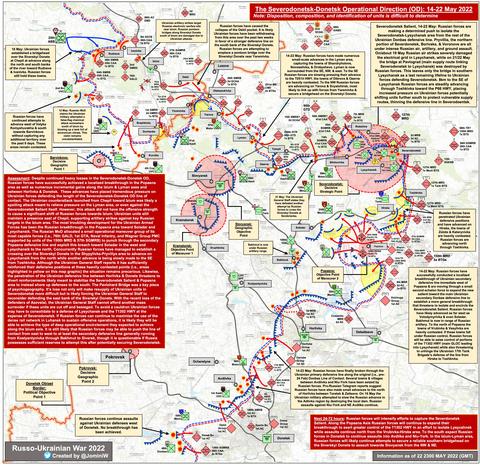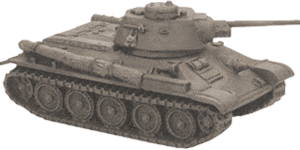Breakthrough In The Donbas: Will It Lead to a Breakout and Encirclement?

One month ago, I wrote of the Battle for the Donbas becoming the focal point of the Russian invasion of the Ukraine. I speculated as to Russian capabilties, intentions, and what might occur. It appears that the Ukrainian position in the Donbas is in big trouble. The question is when will that position collapse, and the answer there is as much a product of Russian decision-making as to how it conducts its war as much as it might be a result of any other factors. The following should help explain why.
The campaign in the Donbas has featured an intensive Russian pounding of deeply entrenched Ukrainian positions. To degrade and destroy the Ukrainian fortifications the Russians have been employing long-range indirect fires, drone strikes, aerial bombardment, and grinding attacks. Mind you, Russian artillery has been pounding these defensive positions for months; it's just that in the last four weeks the intensity of the strikes have reached a higher level yet. This massive expenditure of munitions is producing results. The Ukrainian defenders on the front lines are perhaps even more exhuasted than their Russian tormentors. This outcome is showing on the battlefield - especially in the region surrounding the town of Popasna.
Over the past century, Soviet and then Russian operational art has been built around concentrating force against an enemy’s front so as to achieve a tactical break-in capable of evolving into an operational break-through. The idea there is that such a break-through will lead to a deep operational thrust conducted by mechanized reserves to tear apart and defeat enemy forces. The key to recent Russian successes, which have featured a number of tactical break-in and break-out operations, will be whether the Russians can take advantage and produce an operational success.
All of that will depend upon quite a bit of things happening at once. Some of which should have happened. For instance, the Russians must have already improved their command and control over larger mechanized formations, logistical support of those same units, efficacy in combining arms, and assembled the reserves to take advantage of opportunities exactly like those that have been opened up over the past 48-72 hours in the Donbas. If the Russians have not done those things, then their ability to exploit what has recently been gained will be greatly constrained. To that end, the following explains what has happened of late, and what that means for the next weeks and months of the War in the Ukraine.
On May 8th the Russians captured the key town of Popasna. It is located on high ground dominating the surrounding terrain. This victory positioned the Russians to interdict key Ukrainian lines of communiction in the Donbas. Taking Popansa also represented an important break through of the heavily fortitied Ukrainian defensive lines in the Donbas. In the intervening weeks it has appeared the Russians not only consolidated this gain, but brought in reinforcements and have used Popansa as a springboard to pound the surrounding Ukrainian defensive positions. Again, Ukrainian soldiers have been getting pulverized by incessant shelling from heavy mortars, artillery, multiple-launch rocket systems, and air strikes.
Far to the northwest of Popansa and on the edge of the Donbas is another important transportation center - the city of Izyum. The Russians captured that in mid-April. Since then they have expanded their control over that region in another slow, grinding fight against determined Ukrainian defense. This has been a serious fight that most notably featured the destruction of a good sized Russian mechanized force in a failed river crossing.
Apparently, that Russian set-back has been shrugged off. Consequently, larger cities, like Severdonetsk, are increasingly at risk of being lost. Russian tactics seem to be focused upon cutting lines of communication to Ukrainian defenders of cities and fortified areas followed by Russian troops crushing Ukrainian defensive positions with massive firepower. Only when the Ukrainians are badly weakened by relentless bombardment do Russian forces then move in and take the city or village or town or defensive position in question. That type of assault has been repeated time and again throughout the Donbas during the past month. As a result the outlines of a Ukrainian pocket are being created in the northern part of the Donbas.
Though the push south from the Izyum region has not produced the success Russia has hoped for, it doesn't matter. The loss of Popansa is now really being felt by the Ukrainians. Russian forces in and around Popansa have been reinforced, and have subsequently deepened this initial penetration on axis of advance to the north, west, and south. Worse yet for the Ukrainians, it appears that in the past 72 hours the Russians are forging a breakthrough. If so this will allow them to cut the highway from Bakhmut to the cities of Lysychansk and Severodonetsk. Can they do it? It is likely only a matter of time until all of Luhansk Oblast is in Russian hands. The question is: how much time? For that matter, the city of Bakhmut itself is coming under increasing Russian pressure. How long can it hold? Regardless of the loss of Luhansk Oblast, some of the Ukrainian army's best remaining troops are increasingly facing the potential of being encircled in a large pocket near Lysychansk and Severodonetsk.
Ukrainian forces are fighting hard in some places, but appear to be withdrawing from others. These tactical retreats are important, as they mean abandoning what otherwise were very stable defensive positions (including those southeast of Popansa). The Ukrainian's have taken heavy losses since the war began but have been feeding in reserves. Making matters worse for the Ukrainians, this is not the only place the Russian assault in the Donbass appears to be gaining momentun. There is heavy combat within the city of Lyman, while Sloviansk is in danger of coming under direct assault. If the Russians have gathered the reserves to exploit these multiple axis of advance (in particular those emanating from the Popansa salient) then the Ukrainian position in the entire Donbas is at imminent risk of collapse. Problematically, a Russian Operational Maneuver Group (OMG) in the Popansa area is apparently fighting quite effectively.
What few counter-attacks the Ukrainians are mounting are being defeated or, at best, only achieving localized successes. To date there has been no large scale Ukrainian attempt to launch a true combined arms mechanized counterstroke in the Donbas. If they could, then this would be the time to do it. Every day the Ukrainians do not strike back hard means the Russian chances of developing these breakthroughs into full scale breakouts and then a potential exploitation into the Ukrainian operational rear only grow. Of course, the Ukrainians could fail to effectively counter but see Russian logistical issues undermine their offensive. Such an outcome would definitely assist Ukrainian defensive efforts in stabilizing the situation before it spirals out of control. However, relying on an opponent to make mistakes is anything but a winning strategy.



Post new comment